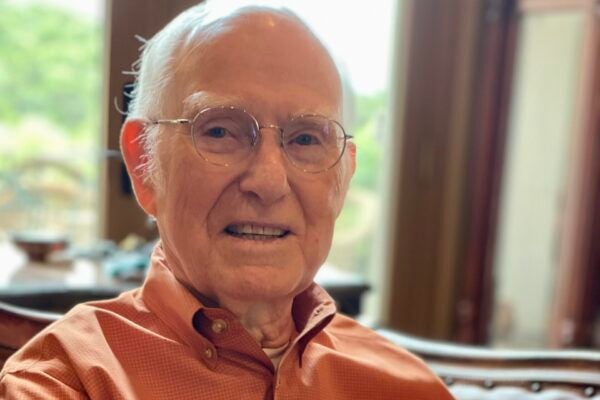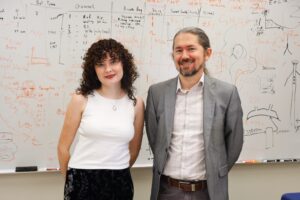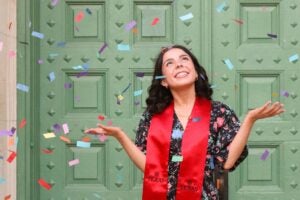Dr. Humboldt “Hum” Mandell, B.S. ’57, sits comfortably on a brown leather sofa, wearing a pressed burnt orange shirt with a white embroidered Longhorn over his heart. Beside him leans a handmade cane, a Texas longhorn carved into its silver handle, a gift from his children. Behind him, a grandfather clock ticks softly.
“I’ve got shelves of books, picture books and places that I’ve been and people I’ve seen, but I don’t look back much. They’re stored here,” he says, gently tapping his head.
Hum carries memories of a career that placed him in the control room at NASA when astronauts walked on the moon, of the great loves of his life and of The University of Texas at Austin, where it all began and where his philanthropy continues to make an impact. His legacy is shaped by timing, talent and a deep connection to UT.
Timing Is Everything
Long before Hum calculated missile stress loads by hand or managed the Mars mission at NASA, his future was taking shape in quiet moments on the Forty Acres. He arrived at UT in 1953 to study aeronautical engineering, a field that wouldn’t officially be called aerospace for years to come. But even then, timing was everything.
When asked about his favorite memory from UT, Hum doesn’t hesitate.
“Meeting my wife,” he says.
Virginia “Ginny” Lee Hurley was studying fine arts at UT. The two were set up on a blind date by mutual friends, and it didn’t go well.
“She thought I was a horrible driver,” he says. “I had a little Studebaker that I drove too fast. So she wouldn’t go out with me again for a while.”
When they crossed paths again a year later, the timing was just right.
“She turned out to be the mother of my children and the love of my life,” he says.
Virginia Mandell was his sounding board, co-host and quiet force behind many of his accomplishments. When Hum founded the Texas Exes Clear Lake chapter, Virginia helped create a sense of hospitality and community that made the group thrive. Hum was later appointed president of the Texas Exes in 1990, a role that deepened his connection to the University that had long shaped his life.
Together, they raised three daughters. “She was the best mother in the world,” Hum says.
After 45 years of marriage, Virginia passed away. To honor her memory, Hum established the Ginny Mandell Memorial Scholarship, which reflects the deep bond they shared and their commitment to giving back to the University they both loved.
In addition to this tribute, Hum created two additional scholarships: the Mandell Family President’s Associates Endowment and the Humboldt C. and Evangeline S. Mandell Scholarship, which honors his parents.
Later in life, Hum met Sally Cowper, B.A. ’60, at the Good Shepherd Episcopal Church. He says she arrived at “just the right time” in his life. The two married, and together they traveled across seven continents. He affectionately calls her his “traveling wife.” Her favorite trip was a Flying Longhorn expedition to photograph a safari in Tanzania. Her love and steady presence enriched his life, and her memory continues to do so after her passing a few years later.
Right Place, Right Time
In 1957, after earning his aeronautical engineering degree at UT, Hum spent three years in the U.S. Air Force before joining McDonnell Douglas, a global aerospace and defense company, where he calculated missile stress loads using calculus. It was a skill he learned at UT that “impressed everybody,” he says, and set him on apath toward a long and impactful career at NASA.
In those early days, long before digital tools were common, mission planning relied entirely on manual calculations and hand-drawn visuals. “There was no computing equipment at all,” recalls Hum. “All we had were slide rules and desk calculators, and the graphics were hand drawn.” We got within a couple percent of what the big computers later calculated,” he says.
There was high demand to be in the control room for the Apollo 11 mission in 1969. Hum felt lucky to have drawn the right straw. “Everybody was watching,” he recalls, “when Buzz Aldrin was about to do his first EVA (extravehicular activity).” The r
oom was dark, and everyone was transfixed, listening to mission control communicate with the astronauts.
In 1975, when NASA announced the Mars mission, Hum was named deputy manager and later promoted to manager of the program — his dream job.

“If enough people retire ahead of you, you eventually get the job you want,” he says laughing. “I’m very lucky to have been born when I was, just the right age for these management jobs to open up.”
Part of Hum’s later work at NASA involved advocating for state support and meeting with public officials to ensure continued investment in the space program.
When Hum retired from NASA after 40 years, his team surprised him with a commissioned painting by Pat Rawlings, a well-known illustrator and space artist, showing him on Mars with his face visible through the helmet of a spacesuit. “They all signed it in silver ink. It brought me to tears,” he says.
Full Circle
After decades at NASA, Hum found himself back where it all began. He returned to UT and volunteered for the next 20 years, teaching aerospace engineering at the Center for Space Research in the Cockrell School of Engineering.
“It just struck me as the thing to do,” he says. “To give back.”
During his time back on campus, he noticed something was missing. Not one Forty Acres Scholar had come from aerospace engineering. He helped change that by supporting the Stamps Forty Acres Scholarship, a premier full-ride award based on merit and administered by Texas Exes. The scholarship is jointly funded by the Stamps Scholars Program and matching donors like Hum, whose contributions expand opportunities for exceptional students. Recipients are selected through a comprehensive review and interview process. After that process, Hum was matched with an aerospace engineering major, through the scholarship’s 1:1 matching partnership, which allows each donor to designate a field of study for their award.
“I just wanted to make sure we had at least one,” he says.
 That one was Jackson Bellard, Bachelor of Aerospace Engineering ‘24, a standout student with towering intellect and, at 6 foot 7, towering height too.
That one was Jackson Bellard, Bachelor of Aerospace Engineering ‘24, a standout student with towering intellect and, at 6 foot 7, towering height too.
“He was chosen from a pool of strong candidates,” Hum says. “It was all talent and merit. That’s how Jackson got picked.”
Jackson is now pursuing a master’s degree in aerospace engineering at UT. Over the past four years, he and Hum have developed a connection extended beyond formal events. Jackson describes him as “a wonderful guide, both personally and professionally,” and says the bonds they built are proof of how donors can create lasting, positive change in students’ lives.
Moved by the scholarship their son received, Jackson’s parents, Bret and Michelle Bellard, partnered with the Stamps Scholars Program to award a Stamps Forty Acres Scholarship to another aerospace engineering student this year.
Looking Forward
“My current hobby is staying alive,” Hum says, with a laugh. “And trying to get back to my office on campus once a week.”
Now in his 90s, what remains clear is how deeply he has given his time: to his country, to the cosmos and always to Texas.
“It was just the right time,” he says. “For all of it.”




